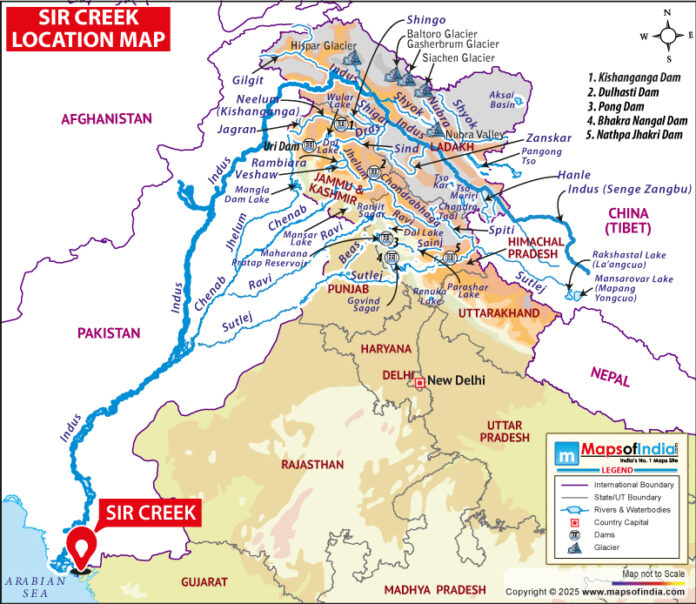The Sir Creek dispute is one of the longest-standing and most delicate geographical disputes between India and Pakistan that has generated geopolitical tension in the region for decades. Sir Creek is a 96-kilometre tidal and marshy Rann of Kutch, which flows into the Arabian Sea, and has become a boundary that is critically important between the two countries. Though it may be perceived as a relatively small geographical problem, the dispute over Sir Creek also has some far-reaching strategic, economic, and maritime implications, and it is a recurrent point of tension in the relations between India and Pakistan.
Location of Sir Creek – Rann of Kutch, Gujarat
Sir Creek is located on the western tip of the Rann of Kutch, which is a large salt marsh area in the state of Gujarat in India. The creek is formed in the Kutch region and empties into the Arabian Sea. Its terrain is largely flat and marshy, and the terrain is vulnerable to tidal changes; hence, demarcation is difficult. This Sir Creek site is of special interest as it influences the maritime boundary of India and Pakistan and sets territorial waters, fishing zones and the Exclusive Economic Zone (EEZ) in the Arabian Sea.
The land is scarcely populated, and the communities in the area are mostly involved in fishing and salt production. Although it is a distant port, Sir Creek is a strategically important area where the possession of such distance could influence access to such precious maritime resources as hydrocarbons, fisheries, and shipping routes.
Historical Background of the Sir Creek Dispute
The Sir Creek disputes date back to colonial times. The borders of Sindh and Kutch during the British rule in India were not clearly defined. The boundary between the Government of Sindh and that of Kutch, as agreed upon in the 1925 resolution, stated that the boundary would be along the eastern flank of the creek. The meaning of this demarcation has, however, been argued.
The undefined boundary has caused controversy since India and Pakistan gained their independence in 1947. According to the agreement of 1925, India believes that the boundary is to the east of the creek, whereas Pakistan asserts that the mid-channel line is more appropriate since tidal changes cause the creek to change course and thus the mid-channel would be the right line.
This uncertainty has been increased by the fact that the marshy, tidal surroundings of Sir Creek, where the creek changes direction more than half an hour, with deposition of sediments and the tide. This means that there is no completely agreed boundary between the two countries, and the dispute remains alive after more than 70 years.
Key Issues in the Sir Creek Dispute
1. Territorial Claims
The main dispute is the issue of what side of the creek the legal land boundary should be. India cites the fact that the maps created historically and the 1925 accord are in its favour on the eastern side, and Pakistan favours the mid-channel boundary. Such a dispute on property ownership is a direct consequence of sovereignty and control over the territory.
2. Maritime Boundary and Exclusive Economic Zone
The position of the land boundary is majorly influential in the Arabian Sea maritime boundary. With the eastern bank under the control of India, it will attain access to more of the maritime territory as well as an expanded Exclusive Economic Zone (EEZ). This is a crucial region in terms of the exploitation of natural resources, including oil and gas reserves and strategic naval benefits.
3. Fishing Rights
The conflict also affects local communities that depend on fishing. Pakistani and Indian fishermen often intrude into the territories of each other in their purported waters, leading to arrests, seizure of boats and diplomatic tensions. Acceptance of the creek boundary has been ambiguous, and thus, it has proven to be challenging to enforce, and as such, there are frequent confrontations.
4. Strategic and Security Concerns
Sir Creek is also located close to major shipping routes in the Arabian Sea and is thus of strategic interest to both countries. Pakistan has at times tried to strengthen its military presence in the region, and as such, India has been on the alert. Over the last few years, Indian defence officials and the Defence Minister, Rajnath Singh, have warned Pakistan against any military build-up in the region as India is determined to defend its territorial and maritime interests.
Efforts to Resolve the Dispute
India and Pakistan have, over the years, tried to solve the Sir Creek dispute by using the diplomatic avenue and technical talks. Different agreements have been entered into the terms of the maritime boundary, but the land boundary that runs along Sir Creek has not been settled.
In 1968-69, both countries decided to constitute a joint technical committee in order to draw a line of the creek, but the process was halted because of the different meanings of ancient maps. The next series of negotiations has taken place at intervals, but no lasting resolution has been arrived at. The ongoing political relationship between India and Pakistan is also volatile, and this issue further complicates the dispute since negotiations are stalled frequently due to the long-standing issues like Kashmir and Sir Creek.
Recent Developments: India’s Stern Warning
India has also threatened, on October 2, 2025, its Defence Minister Rajnath Singh released a strong message to Pakistan about its military build-up on the Sir Creek region. Addressing Dussehra celebrations at Bhuj Military Station in Gujarat, Singh stressed that any aggressive move and or misadventure by the Pakistanis in the Sir Creek sector would be met with stern and decisive action by India. He also added that such a reaction would change both the history and geography of the area. Singh emphasized the strategic importance of Sir Creek because the route to Karachi goes through the creek, and the creek is an element of regional security relationships.
This assertion highlights the strong national security policy and sense of territorial sovereignty of India, even with the escalating tensions between the two, in the strategically valuable Sir Creek region with Pakistan.
Current Status of the Dispute
The Sir Creek dispute is yet to be settled by 2025, but the ground situation is generally stable. There has been no serious anti-hostility between the two countries despite the fact that both countries have nominal claims to their own interpretations of the boundary. The Indian and Pakistani patrols patrol the area sometimes as a way of securing territories, and both countries still use diplomatic options to contain tensions.
Recent events point to the active strategy of India to safeguard its interests. It has been reported that in the region, there has been enhanced surveillance of activities through the establishment of modern and up-to-date coastal security systems in India. Furthermore, India still maintains its stance with diplomatic threats to Pakistan against unilateral attempts to change the status quo.
Even with these efforts, the conflict is still a source of tension that may also affect the overall India-Pakistan relations. According to experts, the solution must be mutually acceptable and may involve new negotiation approaches, which may include third-party mediation or technical arbitration under international law, specifically the United Nations Convention on the Law of the Sea (UNCLOS).
Strategic and Economic Implications
The solution to the Sir Creek problem is important on a number of grounds:
- Maritime Resource Exploitation: There would be a clear boundary in which both countries would be able to govern and exploit the maritime resources, such as oil, gas and fisheries, more effectively.
- Regional Security: Settling the dispute will lessen the number of flashpoints in an already strained India-Pakistan relationship.
- Economic Development: An official agreement would stabilize economic activities and minimize conflicts across borders in the case of local communities reliant on fishing and trade.
Also, the Sir Creek area can be strategically used in naval operations and patrolling shipping routes over the Arabian Sea. Maritime security can be improved by having control over this area, and it increases the geopolitical bargaining power of a nation in the region.
Conclusion
The Sir Creek case is not merely a territorial conflict; it is a multifaceted play of historical obscurities, strategic objectives and economic considerations. The wetlands and shifting nature of the Rann of Kutch have posed a difficulty in demarcating it, and the differing interpretations of the agreements of the colonial period have kept the conflict between India and Pakistan going.
Although the conflict is not completely settled, it highlights the significance of diplomacy, technical negotiation and compliance with international law structures. A solution to this would not only demarcate territorial boundaries to India and Pakistan but would also enhance stability in the region, including economic prospects. Until they have reached such a solution, Sir Creek will remain a sensitive and strategically valuable point on the map of India-Pakistan.





